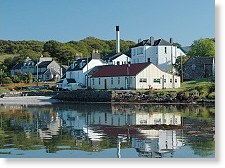|
Isle
of Jura Whisky Distillery

Isle of Jura Tour & Visitor Information
The Isle of Jura Distillery is open for tours all year round,
the only time the visitors centre closes is the two week
period over Christmas and New Year.
During Season / March - October
During the season which runs from the end of March throughOctober,
we are open from 10am until 4pm on weekdays and run tours
at 11am and 2pm.
During Season / Saturdays
The Distillery is open on Saturdays during season from 10am
until 2pm, but there are no tours available.
Off Season
Out of season, the Distillery is open weekdays from 11am
until 2pm and tours are available daily by prior arrangement.
The Distillery is not open at all on the
weekends during off season.
Admission: Free of charge
Contact Sue
for any additional Isle of Jura Tour & Visitor
information as well as for appointments.
Getting There
From Port Askaig, Islay take the Ferry to Feolin (5 minutes,
about £12 return for car and two people) accross the
Sound of Islay. Follow the only single-track road for 6
miles to Craighouse - you can't miss the distillery on your
left. Parking / Reception
Park wherever you can - there is no designated parking lot.
A real Jura welcome awaits you and your tour guide is likely
to be someone working at the distillery.
For true whisky enthusiasts there is one over-riding reason
to come to Jura, and that is to visit its distillery. There
is no quick way of getting to the island of Jura. The fastest
method from London involves two planes, a ferry, and the
best part of a day. Coming by car from Glasgow takes about
the same amount of time. George Orwell, who came here to
write 1984, described it as "an extremely unget-at-able
place." Things haven't changed a great deal since then.
Which is partly what makes this Hebridean
island – producer of the award-winning JURA single
malt – such a magical destination. Only 7 miles wide
and 30 long, Jura is inhabited by 5,000 deer and 180 people.
Although private telephones were installed in the 1970s,
replacing the island's three, don't expect to
get a mobile phone signal here, let along internet access.
With one shop, one pub, a bank that comes once a week and
its 180 year old distillery, it's "as good as
life used to be," as the distillers like to say.
For those who love the great outdoors, Jura is an idyllic
place. Its three ‘Paps' – or mountains
- dominate the skyline, distinguishable from miles around
and the focus for the tough Jura Fells Race which takes
place every May. For those who like to explore, whether
by foot, bike, or yacht, there is a wealth of historical
sites and natural phenomena to discover; from stone circles
and standing stones to ruined castles and iron age forts,
from sandy beaches and secluded coves to stacks, pinnacles
and caves, as well as raised beaches from the ice-age. Golden
eagles, sea eagles, otters and seals are a common sight,
and carry on about their business uninhibited by humans.
Jura's exceptionally mild climate has also allowed
Peter Cool, the gardener at Jura House, to develop an extraordinary
garden within its sheltered walls. Following a trip to Australia
and New Zealand 30 years ago, he brought back numerous seeds
all of which germinated successfully. Now the garden boasts
exotic ferns and grasses which are allowed to mingle with
more traditional garden flowers to bewitching effect.
Jura is an island rich in history, myths and superstitions.
Excavations show it welcomed some of the oldest settlements
in Scotland over 8,000 years ago. It also became a Viking
stronghold, while its ancient grave-yard at Kilearnadil
boasts a number of Knights Templar grave stones and is reputedly
the resting place of a saint. The Corryvreckan whirlpool
– apparently the world's second most powerful –
nearly claimed George Orwell's life. Other claims have been
made recently to suggest it was the inspiration for Scilla
and Charybdis in Homer's epic, The Odyssey. To the North
of the island Maclean's Skull Cave contained a real human
skull, thought to belong to a man slain in a clan battle,
which eventually disappeared in the 1970's. Meanwhile during
the highland clearances, a villager prophesised that the
last laird of the Campbell family would leave the island
one eyed with all his possessions in a cart – which
indeed came to pass, in 1938 when Charles Campbell sold
the estate after it had been in the family for nearly 300
years and the few possessions he took with him were taken
to the boat in a cart drawn by a white horse.
Jura may be hard to get to, but as those who've been there
will testify, it's a place that's even harder to leave.
Courtesy of Isle of Jura Distillery |

